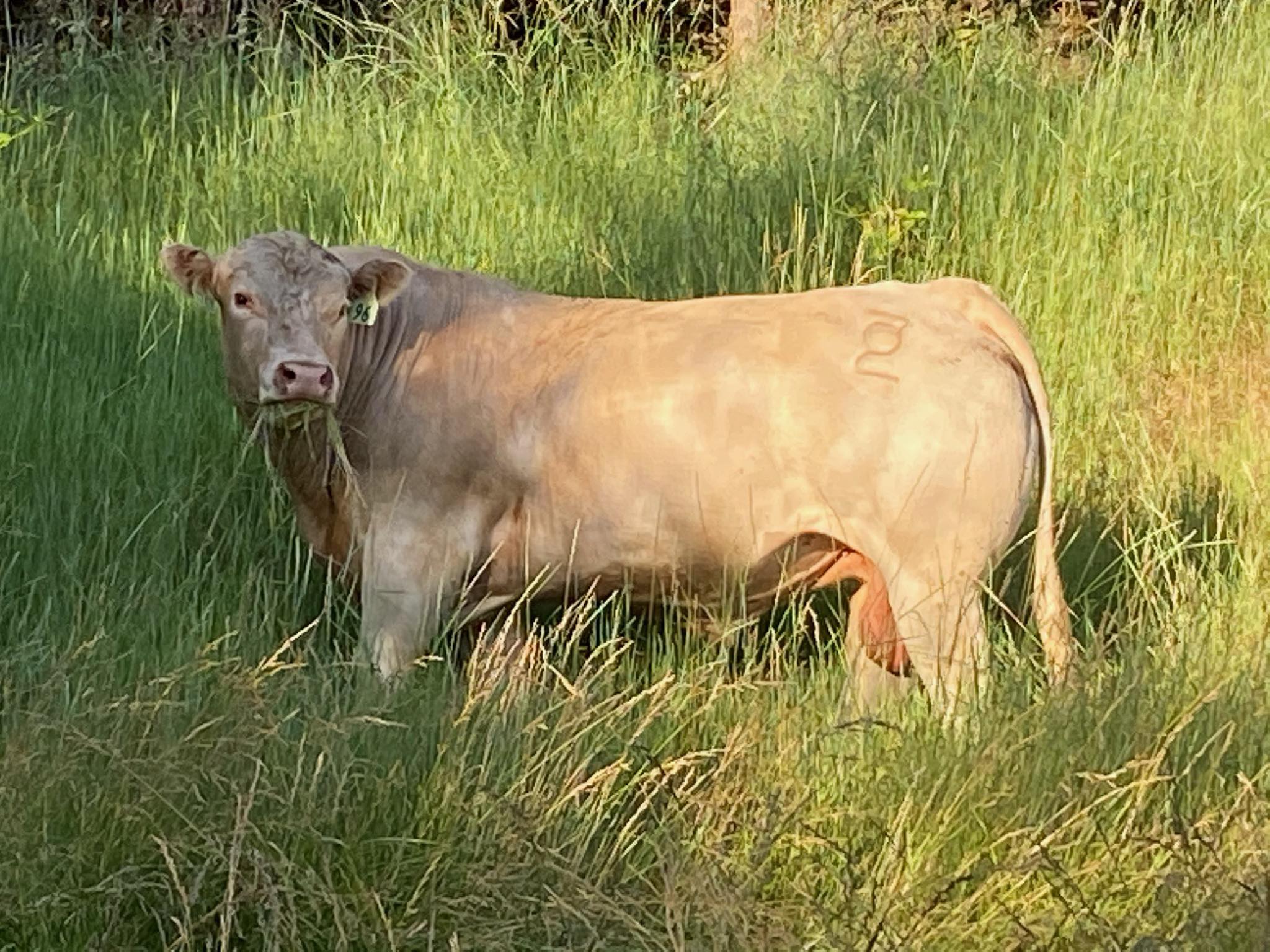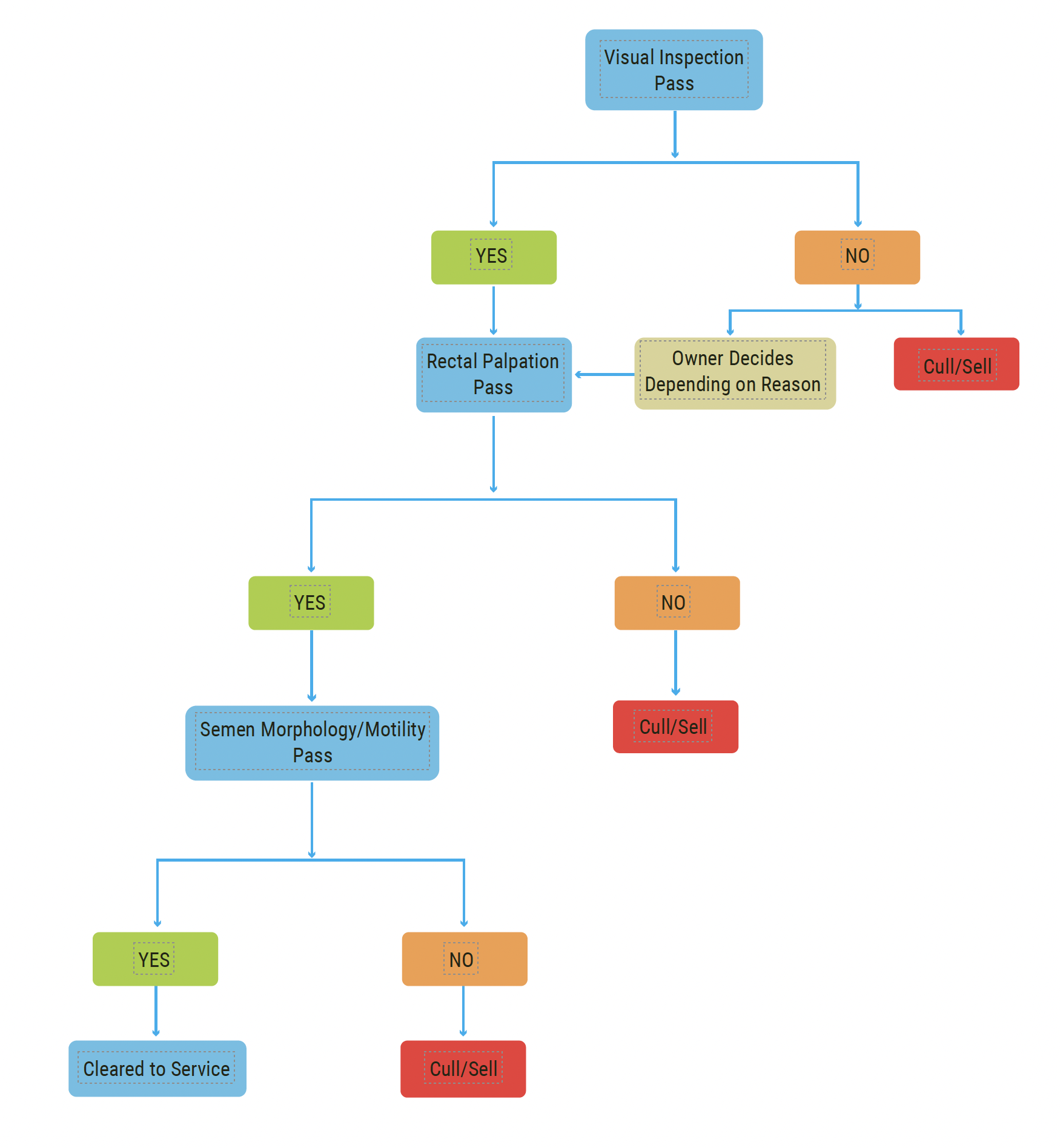Bull Production: Breeding Soundness Exam and Expected Progency Differences

Breeding Soundness Exam
Whether a first-time buyer or a veteran producer, bull selection usually turns up a series of questions for the potential purchaser. The breeding soundness exam (BSE) and expected progeny differences (EPD) are informational sources put in place to aid in the buying process. The BSE’s purpose is to verify the ability and potential of a bull to service (breed) an appropriate number of cows during the breeding season. The bull’s ability or inability to perform a natural service influences the owners’ decisions, including retaining the bull, selling the bull, or perhaps changing breeding strategies. The areas covered in the BSE include rectal palpation, scrotal measurement, visual inspection of the penis and scrotum, body condition of the animal, and a semen evaluation, accomplished via electroejaculation. This process is visually depicted in Figure 1.
Figure 1. Flow Chart Demonstrating the Bull BSE Evaluation Process

Rectal Palpation
Commonly, a veterinarian will begin the BSE by palpating the rectum. The veterinarian will feel along the bull’s reproductive tract, verifying the presence and state of the reproductive organs, including the prostate, seminal vesicles, inguinal ring, and ampule (Gosey, 1983). If any of these organs are damaged or missing, the bull’s owner must be notified.
Visual Inspection
Visually inspecting the animal is another important part of the examination. This inspection includes looking at the bull’s sheath, paying attention to any swelling or abnormalities present, and determining the bull’s body condition. This means considering whether the bull has enough weight for energy conversion during the breeding season, which directly affects reproductive ability and any other body parts that may be of concern, especially the back legs and feet (Bedford-Guaus, 2022).

Scrotal Evaluation
The scrotum is also evaluated to check for health or abnormalities. Several important areas in the scrotal inspection include looking at the size and symmetricity of the testicles to each other (they should look almost identical in both regards), verifying there are two testicles present, and looking for any damage. For example, an injured testicle may have hypertrophied and should be noticeable. A measurement of scrotal circumference is also taken and recorded (Bedford-Guaus, 2022). To pass the BSE, the scrotum must be at least 34 centimeters in circumference (Roding et al., 2021). This can, however, depend on the age and purpose of the bull as well (Bedford-Guaus, 2022).
Semen Evaluation
Evaluating the bull’s semen is usually considered the most crucial part of the examination. Rarely does a bull fail a semen evaluation and greatly improve the next year (if even retained). The evaluation is conducted using an electronic probe inserted rectally into the bull. The electric current on the bottom of the probe stimulates the reproductive organs directly below and results in ejaculate to collect and place on a slide. A veterinarian (responsible for conducting the BSE) then stains the slide and places it underneath a microscope to view the individual spermatogonia. To pass the examination, two different spermatic characteristics are evaluated, morphology (appearance) and motility (movement). For example, in a normal scenario, a veterinarian will collect the sample and count 100 individual spermatogonia. If 70 or more of the spermatogonia are normal in shape and appearance, then the bull passes the morphology portion of the exam. If 30 or more of those individual spermatogonia are displaying good movement, then the bull passes the motility portion of the evaluation. If either one is not met, the BSE is not a pass (Maxwell, 2018).
BSE vs Expected Progeny Differences
With expected progeny differences (EPD), we are looking at a futuristic probability in the offspring that corresponds to the EPD numbers of the bull (sire) or cow (dam). EPDs are extensive and beyond the scope of this brief overview; however, it is important to recognize how the BSE also translates to a bull you may or may not see at the auction. One factor from the BSE especially present in most EPDs and auction information is the scrotal circumference. Scrotal circumference is a genetic trait that should cause some to remember the heritability factors involved in breeding cattle. Moreover, scrotal circumference also can directly relate to breeding potential (Kastelic, 2014). A larger scrotal measurement will stand out in the auction magazine and increase the value of an individual bull. See Table 1 for an example of an EPD chart you may see in a sale catalog.
Table 1. Sample EPD Chart With Several Parameters, Including Calving Ease (CE), Scrotal Circumference (SC), Weaning Weight (WW), Birthweight (BW), Yearling Height (YH), and Accuracy (Acc)
| Measurement | Calving ease (CE) | Scrotal circumference (SC) |
Weaning weight (WW) | Birth weight (BW) | Yearling height (YH) |
|---|---|---|---|---|---|
| EPD | 14 | 1.1 | 78 | 102 | 1.2 |
| Accuracy (Acc%) | 0.23 | 0.21 | 0.12 | 0.17 | 0.09 |
Summary
The importance of a BSE cannot be stressed heavily enough in bull production. Purebred producers, commercial operators, and small operations all depend on a bull’s ability to provide viable spermatogonia and physically service females. Retaining a bull that is unable to do so is an economically detrimental mistake. A thorough BSE can help ensure breeding potential and reliable investments for producers. Moreover, understanding the many acronyms adopted by the cattle industry is crucial to making sound management decisions.
References
-
Bedford-Guaus, S. J. (2022, October). Breeding soundness examination of bulls - management and nutrition. Merck Veterinary Manual. Retrieved April 19, 2023, from https://www.merckvetmanual.com/manage-ment-and-nutrition/breeding-soundness-examination-of-the-male/breeding-soundness-examination-of-bulls
-
Gosey, J. A. (1983). Breeding soundness examination of beef bulls [G83-666]. University of Nebraska - Lincoln Extension. https://digitalcommons.unl.edu/extensionhist/321
-
Kastelic, J. P. (2014). Understanding and evaluating bovine testes. Theriogenology, 81(1), 18-23.
https://doi.org/10.1016/j.theriogenology.2013.09.001. -
Maxwell, H. (2018). SFT bull breeding soundness examination standards update. Auburn University College of Veterinary Medicine.
-
Rodning, S., Rush, J., Kelley, K., Runge, M., Elmore, M., Dyce, P., Schnuelle, J. G., Hopper, R., Wolfe, D., & Armstrong, C. (2021, March 26). Bull breeding soundness examinations. Alabama Cooperative Extension System. Retrieved April 19, 2023, from https://www.aces.edu/blog/topics/beef/bull-breeding-soundness-exam-inations/#:~:text=Bulls%20must%20have%20at%20least,sperm%20to%20pass%20a%20BSE.
April 2024
Utah State University Extension
Peer-Reviewed Fact Sheet
Author
Ethan Gilliam


